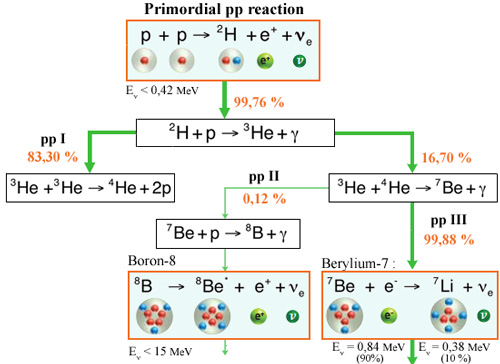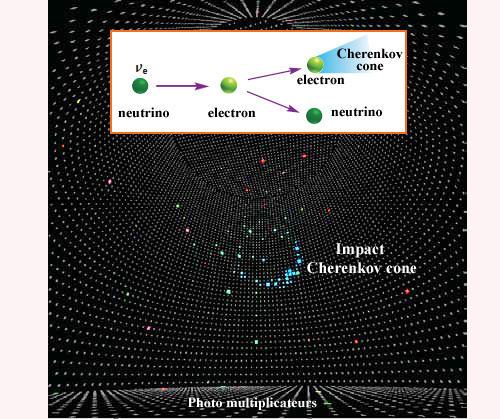Hunting down neutrinos and the resolution of an enigma.
Nuclear fusion reactions produce a large number of neutrinos in the sun. When they are detected, these neutrinos, are an evidence of the fusion reactions in the sun.
These neutrinos take 2 seconds to get through the sun and some 8 minutes to reach us. Their number is phenomenal. To give an idea, each square centimeter of the Earth’s surface is crossed every second by 65 billion solar neutrinos. But these neutrinos are extraordinarily difficult to bring out. Out of 100,000 billion solar neutrinos that hit the Earth’s surface, there will be less than one interaction with an atom of our planet.

Three sources of solar neutrinos
This diagram of the nucleosyntheses taking place in the sun shows the three main reactions producing neutrinos. The first is the fundamental pp fusion reaction of two protons to form a deuterium nucleus: the main source of nucleosyntheses energy and neutrinos. Following this primordial nucleosynthesis, other reactions generate neutrinos, in particular those involving berilyum-7 and the disintegration of Boron-8. The percentages indicate the proportion of possible channels. Neutrino energies are also given.
© IN2P3
The main source of neutrinos is the fusion reaction of two protons which leads to the deuterium nucleosynthesis, called by physicists reaction pp. The pp reaction is the first of the nucleosyntheses occuring in the sun, the one that provides most of its energy: 92% of the solar neutrinos (called « primordials ») are produced in this reaction.
The newly formed deuterium made of a proton and neutron, quickly fusions with a proton to give a helium 3 nucleus. Then, in 83% of the cases, a new fusion reaction leads to helium-4 the most stable of the light nuclei, which is nothing but an alpha particle.
In 17% of the cases, helium-3 fuses with helium-4 to generate a 7-beryllium nucleus that decays into lithium-7 through electron capture by emitting a neutrino. Finally, very rarely beryllium-7 merges with a proton, to form boron-8 which emits a neutrino by beta decay. These two fusions are two sources of neutrinos which add up to those of the reaction pp.
Such are the main sources of solar neutrinos. The energy of primordial neutrinos, the most abundant , does not exceed 0.420 MeV and differs little from that of neutrinos in radioactivity. These low-energy neutrinos are difficult to show up. It took all the sensitivity of the detector Gallex and similar large detectors to record them. On the other hand, the more energetic beryllium-7 neutrinos – mainly 0.84 MeV – are more identifiable. Boron neutrinos, although rarer, are the easiest to detect and identify because their energy can be up to 15 MeV.

Neutrinos fluxes and detection ranges
Energy distribution of solar neutrinos : primordial neutrinos of the pp reaction, beryllium-7 and boron-8 neutrinos. Boron neutrinos are by far the least numerous, but their much higher energy facilitates detection. The detection ranges of the various observatories are indicated by the arrows in green (top). The Super-Kamiokande first observatory could only detect boron neutrinos of a few MeV whereas more recent observatories such as Gallex were able to descend to 0.233 MeV and detect primordial neutrinos.
© IN2P3
A deficit of detected solar neutrinos ?
In the early 1970s, American physicist Raymond Davis (1914-2006) installed a reservoir of 400,000 liters of tetrachlorethylene at the Homestake gold mine, South Dakota, at a depth of 1,500 meters. Neutrinos can transmute chlorine-37 (an isotope of chlorine) nuclei into argon 37, a radioactive isotope. With ingenuity, Davis succeeds in extracting, purifying and counting generated argon atoms. With patience, about 2,000 argon atoms were thus detected and counted during more than twenty years, … only 30% of the number expected from the sun.
From 1988, the Super-Kamiokande Observatory in Japan confirmed this deficit. The target consisted of 2,100 tonnes of very pure water. Some neutrinos wera able to set fast electrons in motion. These fast electrons emitted a Cherenkov flash light that allows to detect detected. But only the energetic boron neutrinos generated enough light to do so.

A neutrino event
Neutrino event recorded by the Super-Kamiokande Observatory in Japan in 1998. The observatory consists of a 40 meters high and 40 meters in diameter cylinder located in a mine under a mountain and filled with very pure water. Its walls are covered with photomultipliers. An energetic several MeV boron neutrino propelled forward a target electron in the water. The electron that travels faster than light in water emits a conic flash of Cherenkov light, detected by the photomultipliers. The trace of the cone on the walls makes it possible to go back to the direction of the neutrino which points here towards the sun
© Super Kamiokande
In the late 1980s, two neutrinos observatories, SAGE and GALLEX, were built under the Caucasus mountains and under the Great Sasso in Italy. They used gallium that low-energy neutrinos (above 233 keV) can transmute into a germanium radioactive isotope. In 1992, GALLEX announced the first observation of the primordial neutrinos resulting from the fusion reactions between two protons in the heart of the Sun. The flux of primordial neutrinos was again measured less by a good third than the predictions of the astrophysicists. The neutrino deficit therefore involved not only the energetic boron, but also the primordial neutrinos!
The enigma solution : neutrinos oscillate
To explain this deficit, the hypothesis was advanced of neutrino oscillations, notably during an experiment carried out in 1999 at the Kamiokande observatory near Tōkyō by the team of the japanese physicist Masatoshi Koshiba: a fraction of solar neutrinos would « metamorphose » during their journey in other types neutrinos that escape detection… Neutrinos produced in the sun are neutrinos-electrons, able to interact in terrestrial detectors. The other two species of neutrinos – neutrino-mu and neutrino-tau – do not interact in general. If during the 8 minutes that solar neutrinos take to reach the sun, a large fraction of them transform into neutrinos mu or tau, one would observe a deficit of interactions in observatories.